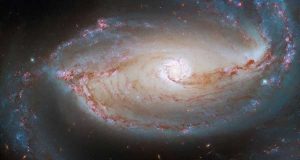Hubble Captures Amazing Pictures Through its Gravitational Lens. NASA’s Hubble Space Telescope has captured the first of a group of five star-shaped quasar stars.
What is Gravitational Lensing?
The effect of the many images seen in the Hubble image is produced by a process called gravitational lensing, in which the gravitational field of a large object – in this case, a galaxy which bends and magnifies light into an object,in this case, a quasar which is behind it.
Also Read: The Hubble Space Telescope is actually a Boon to Astronomy
Although many examples of gravitational lenses have been observed, this “quasar quasar” is the only one so far when most quasar images are produced by a collection of galaxies that act as a magnetic field lens.
The back of the quasar is the bright backbone of the galaxy. It is powered by a black hole, which consumes gas and dust and creates a stream of light in the process.
How Was The Picture Taken?
When a quasar light passes through the gravitational force of the galaxy between us and the quasar, light is trapped by a magnetic field that rotates in the atmosphere in such a way as to produce five different images of the object surrounding the center of the galaxy. The fifth quasar image is embedded to the right of the center of the central galaxy in the collection. The collection also creates a web of images of other distant galaxies hanging from the arcs.
Recent Read: Ukraine-Russia Crisis threaten on International Space Station
The old lens collection is known as SDSS J1004 + 4112 and was found in the Sloan Digital Sky Survey. It is one of the most distant galaxies (about seven billion light-years), and it appears to have originated when the universe became part of its present era.
Spectral data taken from the 10-meter Keck I telescope indicate that these are images of the same galaxy. The spectral effects are similar to those assumed by the lens model based solely on the image area and the dimensions of the light emitted from the quasar.
How is it Unique?
This image is the first to split a single distant quasar into five images, showing many banana-shaped arcs in the background galaxies and even supernovae. Four of the five quasar images can be seen as star-like images surrounding the cluster’s center. The fifth quasar image is embedded to the right of the cluster’s central galactic center.
